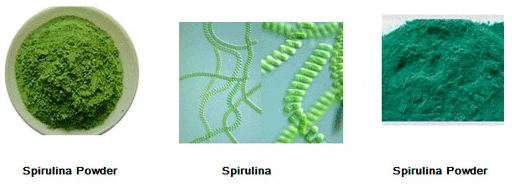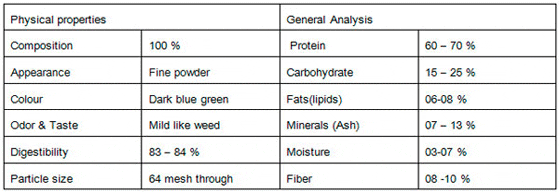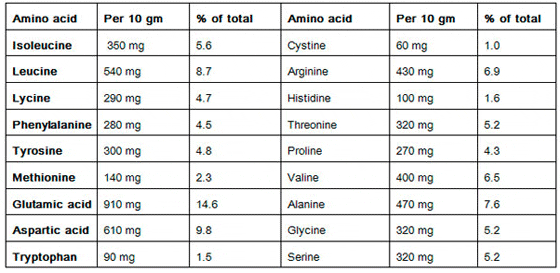Spirulina is a blue green algae like a spiral of long thin threads under genus Arthrospira, the phylum Oscillatoriaceae. Spirulina is called blue green algae (Cynobacteria) because of presence of both green (chlorophyll) and blue (phycocyanin) pigments in its cellular structure. The two common species more important for their nutritious value are Spirulina maxima and Spirulina plantensis.

NUTRITIONAL FOOD VALUE: Spirulina is used as a complementary feed in various sectors of aquaculture due to it causing fast growth and enhancing the pigmentation and immunity systems. It is considered an excellent food, lacking toxicity and having corrective properties against the pathogenic micro organisms. It lacks cellulose cell walls and therefore does not require chemical or processing in order to become digestible. The digestibility is 83 – 84 %. Spirulina is regarded as a rich source of protein, vitamins, essential minerals, amino acids, EFFA like gamma LNA and antioxidant pigments like carotenoids.
Nutritional Profile of Spirulina Powder

Biochemical Composition
Protein & Amino acids: Spirulina contains 60-70% protein along with phenolic acids, tocopherols, carotenes and linolenic acids, which are important in diets. The essential amino acids present are around 47 % of total protein weight. The spectrum of amino acid represent that the biological value of proteins in spirulina is very high.
Amino acid and Biological function of Fishes & Shrimps
- ISOLEUCINE: Required for optimal growth, nitrogen equilibrium in the body .Used to synthesize other non-essential amino acids.
- LEUCINE: Increases muscular energy levels.
- LYSINE: Building block of blood antibodies, strengthens circulatory system and maintains normal growth of cells.
- METHIONINE: Vital lipotropic (fat and lipid metabolizing) amino acid that maintains liver health. An anti-stress factor.
- PHENYLALANINE: Stimulates metabolic rate.
- THREONINE: Improves intestinal competence and digestive assimilation.
- TRYPTOPHANE: Increases utilization of B vitamins, improves nerve health.
- VALINE: Stimulates muscle coordination
Essential Amino Acids in Spirulina

Cabohydrates: Spirulina contains about 15 -21 % carbohydrates in the form of Glucose, fructose, sucrose, rhamnose, mannose, xylose and galactose. It provides the appropriate and important food stuff for aquatic culture animals with problems of poor intenstinal absorption. Carbohydrates occur in sufficient quantities of mesoinositol phosphate which is the excellent source of organic phosphorus and inositol. A high moleculatory weight of polysaccharide are believed to have effect on DNA repair mechanisms, immune-stimulatory and immunoregulatory properties.
Nucleic acids: Spirulina contains 2.2 % - 3.5 % of RNA and 0.6 %-1% and DNA, which represents less than 5% of these acids, based on dry weight.
Essential fatty acids: Spirulina has a high amount of polyunsaturated fatty acids (PUFAs) and 1.5–2.0 percent of total lipid. Spirulina is rich in γ-linolenic acid (ALA), linoleic acid (LA), stearidonic acid (SDA), eicosapentaenoic acid (EPA), docosahexaenoic acid (DHA) and arachidonic acid (AA).
β-carotene and vitamins: Spirulina contains vitamin B1 (thiamine), B2 (riboflavin), B3 (nicotinamide), B6 (pyridoxine), B9 (folic acid), B12 (cyanocobalamin), vitamin C, vitamin D and vitamin E. The β-carotene, B-group vitamin, vitamin E, iron, potassium and chlorophyll available in the spirulina can promote the metabolism of carbohydrate, fats, protein, alcohol, and the reproduction of skin, muscle and mucosa. Spirulina contains large amounts of natural β-carotene and this -carotene is converted into vitamin A.
Minerals: Spirulina is a rich source of potassium, and also contains calcium, chromium, copper, iron, magnesium, manganese, phosphorus, selenium, sodium, zinc, molybdenum, chloride, germanium and boron.
Photosynthetic pigments: Spirulina contains many pigments including chlorophyll a, xanthophyll, betacarotene, echinenone, myxoxanthophyll, zeaxanthin, canthaxanthin, diatoxanthin, 3-hydroxyechinenone, beta-cryptoxanthin, oscillaxanthin, plus the phycobiliproteins, c-phycoc yanin and allophycocyanin.
Natural Pigment Enhancers: Phycocyanin (Blue): 14%, Chlorophyll (Green): 1% , Carotenoids (Orange/ Red): 47%.
Nutritional Supplementary Property
Spirulina can be used as a partial supplementation or complete replacement for protein in aqua feeds. Spirulina is a feed supplement for the all fishes, giant freshwater prawns and marine water shrimps and significantly improvement occurs on growth, survival, immunity, viability and feed utilization. Spirulina is a cheaper feed ingredient with high protein than others of animal origin. Spirulina diet is found as most suitable supplementary feeding to reduce the cultivation time and mortality, and increase shell thickness of shrimp carapace. Feeding of spirulina helps to improve disease resistance and an improvement in survival rate. Fast growth occurs when fed a diet containing spirulina meal (Britz, 1996)
Chelating of toxic minerals (neutralization of toxic minerals): Spirulina has a unique quality to detoxify (neutralize) or to chelate toxic minerals, and this characteristic is not yet noticed in any other microalgae (Maeda and Sakaguchi, 1990; Okamura and Aoyama, 1994). Spirulina can be used to detoxify arsenic from water and food. It also may be used to chelatize or detoxify or neutralize the poisonous effect of heavy metals (minerals) from water, food and environment. Spirulina provides phycocyanin, a source of biliverdin which is among the most potent of all intra-cellular antioxidants.
Immunomodulatory Property: Spirulina is an effective immune modulator. It exhibits anti inflammatory properties, in particularly by inhibiting the release of histamine from mast cell with mediated allergic reactions. It shows antioxidative and free radical scavenging properties. Spirulina exposure enhances the phagocytic functions of macrophages in aquatic culture animals. It also has antiviral and anticarcinogenic properties. It improves the bacterial gut tract clearance potential of fish/shrimp and spirulina supplements develops the phagocytic cell. Spirulina is safe to use in terms of improved immune competence without compromising the performing behaviors of aquatic culture animals. A novel sulphate polysaccharide of spirulina inhibits the replication of several enveloped viruses.
The nutrients of spirulina help to fight free radicals, cell-damaging molecules absorbed by the body through pollution, poor diet, injury, or stress. By removing free radicals, the nutrients help the immune system fight cancer and cellular degeneration. Spirulina is a powerful tonic for the immune system. This enzyme is a major source of super oxide in an animal’s body, and is involved in dozens of degenerative processes involved in disease resistance, aging and similar processes in fish, shrimp and other aquatic animals
Spirulina in building red blood cells and stem cells: Spirulina is rich in a brilliant blue polypeptide called Phycocyanin. Phycocyanin affects the stem cells that make up the cellular immune system and red blood cells that oxygenate the body. Phycocyanin stimulating hematopoiesis, (the creation of blood), emulating the affect of the hormone erythropoetin, (EPO). Phycocyanin also regulates production of white blood cells, even when bone marrow stem cells are damaged by toxic chemicals or radiation.
Spirulina Anti-Viral and Anti-Cancer abilities: Calcium-Spirulan is a unique polymerized sugar molecule extract of spirulina and contains both Sulfur and Calcium. The treatment of this water soluble extract has better recovery rates when infected with a lethal Herpes virus. This mechanism occurs because Calcium-Spirulan does not allow the virus to penetrate the cell membrane to infect the cell. The virus is stuck, unable to replicate. It is eventually eliminated by the body's natural defenses. Spirulina can prevent or inhibit cancers in aquatic animals, and fishes. The unique polysaccharides of spirulina enhance cell nucleus enzyme activity and DNA repair synthesis.
Antimicrobial Property: Spirulina excretes variable quantities of products from its metabolism such as organic acid, vitamins and phytohormones. Cell extract of spirulina has shown antimicrobial activities against pathogenic bacteria as like Bacillus sps, Streptococcus sps, Saccharomyces sps etc.
Bio-mineralization activities: Spirulina thrives in high alkaline waters and it incorporates & synthesizes many minerals and derivative compounds into its cell structure. Transformed into natural organic forms by Spirulina, minerals become chelated with amino acids and they are more easily assimilated by the body. Along with adequate calcium and magnesium in the water (especially for marine organisms), Spirulina helps insure proper electrolyte function, calcium levels over calcium and other mineral.
Enhance the Reproduction activity: Research has shown that fresh and saltwater fish and shrimp exhibit superior growth, maturity, energetic behavior, and more elegant coloring when fed spirulina. It is also well documented that spirulina improves spawning, fecundity, fertility and hatching rates. It stimulates the reproductive processes, increases survival rates of younger fish, post larvae and promotes the appetite of fish/prawn to attain full mature.
Spirulina as a colourant: The color appearance is the most important characteristic in case of shrimps and fishes for choice & demand in food market. Spirulina diet promotes the physiological activities for generating the color pigmentations and glazing appearance in various parts of body. Carotenoids are responsible for the development of various colours of crustaceans (Britton et al., 1981). Astaxanthin has been shown to be the predominant carotenoid associated with the red body colour of the black tiger prawn Penaeus monodon (Howell and Matthews, 1991). Spirulina platensis & pacifica stain contains the highest levels of ?-carotene and zeaxanthin of any natural source .They both are converted to astaxanthin through an oxidative process for the desire red pigment. A marked increase in carotenoid content of the carapace of black tiger shrimp (Penaeus monodon) occurred when spirulina-supplemented diets are given. A practical strategy for the improved pigmentation of cultured P. monodon is the incorporation of spirulina diet for one month before harvest.
Conclusions
As a natural feed resource, Spirulina plays an important role in aquaculture. Especially in aquatic farming and hatchery etc, the results are quite significant. If spirulina feed further improves to the microcapsules, help digestion, and promote the shell development and its effect are more obvious. The prospects of Spirulina will be very bright in the feed applications. Spirulina appears to have considerable potential for development, especially as a small-scale crop for nutritional enhancement, livelihood development and environmental mitigation. Spirulina is widely used in aquaculture and it can promote the growth of cultured species, increase appetite, increase disease resistance, and increase the survival rate of larvae in aquaculture, and it’s breeding fast and easy to cultivate.
March 2013


